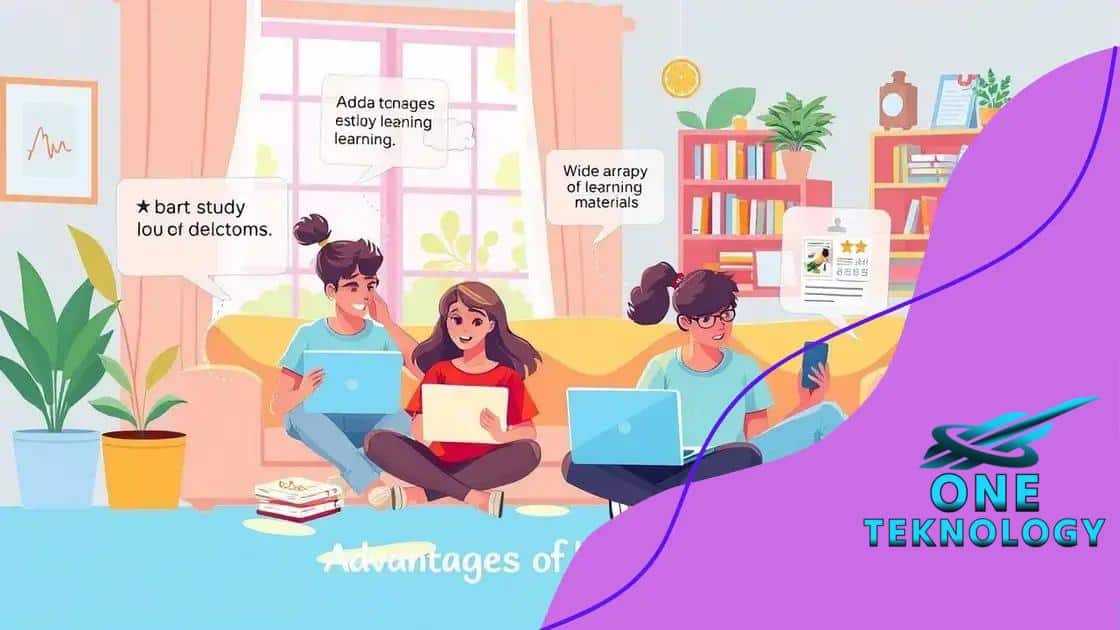The rise of online education platforms in global markets

The rise of online education platforms in global markets has transformed learning through increased accessibility, personalized experiences, and innovative technologies such as AI, VR, and micro-credentials.
The rise of online education platforms in global markets has changed how we think about learning. Have you ever wondered how these platforms are making education more accessible around the world? Let’s dive into this fascinating topic.
The evolution of online education
The evolution of online education has transformed how we approach learning and teaching. From the early days of simple email correspondence courses to today’s sophisticated platforms, the changes are profound.
Online education began in the late 20th century, making a significant impact on traditional learning environments. As technology advanced, so did the methods of instruction, creating more interactive and engaging experiences for learners.
Key Milestones in Online Education
Several key milestones have marked the journey of online education. Each advancement has contributed to its growing popularity and accessibility. Here are some notable milestones:
- 1990s: Introduction of the first online courses through universities.
- 2000s: Growth of Massive Open Online Courses (MOOCs), allowing thousands of learners to enroll.
- 2010s: Rise of mobile learning applications, enabling education on-the-go.
- 2020s: Increased adoption during the COVID-19 pandemic, making online learning a necessity.
The shift toward online platforms has also expanded access to education across different demographics. For instance, students in remote areas can now attend classes from prestigious institutions without the need to travel.
Moreover, the emergence of video conferencing tools has made live classes possible, creating a more interactive and immersive learning environment. Students can engage with peers and instructors in real-time, fostering a sense of community that is essential for effective education.
Benefits of Online Education Evolution
The evolution of online education brings numerous benefits, including flexibility and affordability. Students can learn at their own pace, fitting their studies into their schedules. This flexibility is especially beneficial for those juggling work, family, and education.
Additionally, online courses often come at a lower cost compared to traditional schooling, making education more affordable for many. This democratization of education ensures that more individuals can pursue their learning goals.
The evolution of online education has not only changed how we learn but has also prompted educational institutions to rethink their methodologies. As we continue to innovate and adapt, the future of education looks bright, promising even more exciting developments ahead.
Key players in the online education market
Understanding the key players in the online education market is essential to grasp how this sector operates. Various platforms and institutions have emerged, each contributing to the landscape of digital learning.
Some of the most influential organizations have revolutionized access to education. These platforms offer a range of courses across different subjects, helping learners achieve their personal and professional goals.
Major Online Education Platforms
Several notable platforms dominate the online education market. They are recognized for their wide reach and diverse offerings:
- Coursera: Partners with universities to offer online courses and degrees.
- Udacity: Focuses on tech-related courses, particularly in programming and data science.
- edX: Provides courses from top institutions, often as part of a MicroMasters program.
- Khan Academy: Offers free resources for learners of all ages, focused primarily on K-12 education.
These platforms not only provide educational opportunities but also create partnerships with businesses to equip learners with industry-relevant skills. This collaboration helps bridge the gap between education and employment.
In addition to these platforms, traditional universities are also adapting to the online education model. Many have developed their own online courses and degree programs, recognizing the demand from students who seek flexibility.
Moreover, key players include startups that focus on niche markets, leveraging innovative technologies to enhance learning experiences. For example, some utilize gamification to make learning more engaging and interactive.
The Impact of Key Players
The influence of these key players stretches beyond just offering courses. They actively shape educational policies and practices, setting standards for online learning. Their success has demonstrated the effectiveness of online education, encouraging more institutions to enter this space.
As competition grows, these platforms continue to innovate, adopting new technologies such as Artificial Intelligence and Virtual Reality to enhance learning. This evolution keeps the learning experience fresh and relevant for students.
Benefits of online learning for students

The benefits of online learning for students are numerous and transformative. With the rise of technology, education has become more accessible, affordable, and flexible than ever before.
One of the most significant advantages is the flexibility online learning provides. Students can learn at their own pace and fit their studies into their schedules. This is especially important for those who balance work, family, and other commitments.
Accessibility to Diverse Resources
Another notable benefit is the accessibility to a wealth of resources. Online students often have access to:
- Extensive libraries: Digital libraries and resources that can be accessed at any time.
- Variety of courses: Options across various subjects and fields from multiple institutions worldwide.
- Interactive tools: Innovative learning tools that enhance the educational experience, such as virtual simulations and forums.
Additionally, online learning provides opportunities for personalized education. Many platforms allow students to customize their learning paths to suit their individual needs and interests, leading to a more engaging experience.
The social aspect of online learning should not be overlooked. Students can connect with peers and instructors from diverse backgrounds. This interaction fosters a global classroom environment, where different perspectives enrich the learning process.
Cost-Effectiveness
Cost is another factor that makes online learning attractive. Students often save on transportation and housing costs, and many online programs offer lower tuition rates compared to traditional in-person classes.
The flexibility, accessibility, personalization, social interaction, and cost-effectiveness of online learning create a comprehensive educational format. Students can thrive in an environment that adapts to their needs, leading to improved academic performance and personal growth.
Challenges faced by online education platforms
Online education platforms have made significant strides, but they also face several challenges. Recognizing these obstacles is essential for improving the quality of education delivered online.
One major issue is the digital divide, which refers to the gap between those who have easy access to the internet and technology and those who do not. This disparity can lead to unequal learning opportunities, especially for students in remote or underserved areas.
Quality of Content
Another challenge is ensuring the quality of content provided on these platforms. With so many courses available, it can be difficult for students to discern which are credible and valuable. Some platforms struggle to maintain consistent quality across their offerings, leading to varying experiences for learners.
Additionally, the increasing number of educational resources can overwhelm students. Without guidance, they may find it hard to navigate through countless options, making it challenging to choose the right course.
Engagement and Retention
Another significant challenge is keeping students engaged in an online environment. Traditional classroom settings offer personal interaction, which can foster motivation and participation. Online courses must find innovative ways to maintain student engagement. Techniques like gamification and interactive elements are often used, but not all platforms successfully implement these strategies.
Moreover, student retention can be a struggle. High dropout rates are often observed in online courses, partly due to isolation and lack of accountability. This is compounded by the flexibility of online learning, which might lead some students to procrastinate.
Lastly, there is the challenge of technical issues. Poor internet connectivity, software glitches, or user-unfriendly interfaces can hinder the learning experience. These problems can frustrate students and detract from their ability to absorb material effectively.
Future trends in global online education
The future trends in global online education show exciting potential as technology continues to evolve. Educational institutions and platforms are adapting to provide better learning experiences for students around the world.
One major trend is the adoption of artificial intelligence in online learning environments. AI can personalize learning pathways, provide real-time feedback, and help track student progress effectively. This technology can also assist instructors in identifying areas where students may struggle, allowing for timely interventions.
Increased Use of Virtual and Augmented Reality
Another significant trend is the increasing use of virtual reality (VR) and augmented reality (AR). These technologies create immersive learning experiences that allow students to engage with the content in new ways. For example, medical students can practice surgeries in a simulated environment, while history students can explore ancient civilizations through interactive simulations.
This heightened engagement can lead to better retention of information. Furthermore, VR and AR can transport students to locations and situations that would be impossible in a traditional classroom setting, enhancing their understanding of complex subjects.
Rise of Micro-Credentials and Nano-Degrees
The demand for micro-credentials and nano-degrees is also rising. These shorter, focused programs allow learners to acquire specific skills quickly. As the job market continues to change, individuals are seeking ways to stay competitive and relevant. Micro-credentials offer a solution by providing targeted education tailored to industry needs.
This trend is particularly appealing for adult learners and professionals who may not have the time to commit to a full degree program. It empowers them to upskill and reskill efficiently, aligning their education with their career goals.
Furthermore, online education platforms are increasingly emphasizing collaborative learning. Features that encourage peer interaction and teamwork are becoming standard. This collaboration mimics real-world work environments, preparing students for the modern workplace.
The impact of these trends is expected to reshape the educational landscape dramatically. As technology advances, the traditional educational model will adapt, offering more flexible, engaging, and effective options for students everywhere.
FAQ – Frequently Asked Questions about Online Education Trends
What are the benefits of online education?
Online education offers flexibility, accessibility to resources, and personalized learning experiences for students worldwide.
How is artificial intelligence used in online learning?
AI is used to customize learning experiences, provide real-time feedback, and help track student progress effectively.
What role do VR and AR play in education?
VR and AR create immersive learning experiences that enhance engagement and understanding of complex subjects.
What are micro-credentials?
Micro-credentials are short, focused courses that help learners acquire specific skills quickly, aligning education with industry needs.






